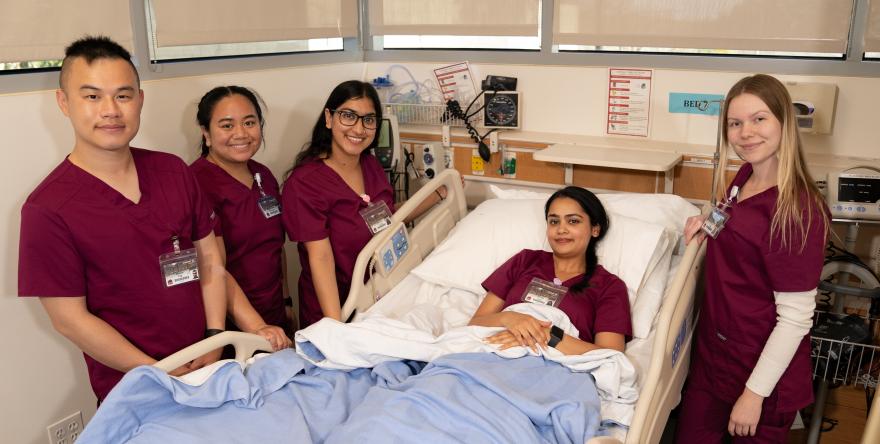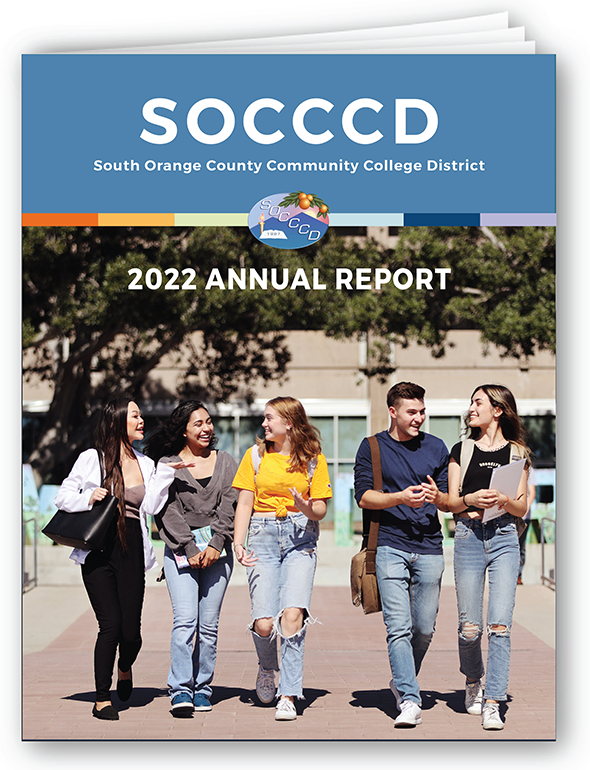SOCCCD is proud to be a leader in the areas of higher education and workforce development in Orange County and throughout the southern California region. Through a commitment to excellence—staff, faculty, and administration work to provide an exemplary experience for students to achieve their career and academic goals.
CA Community College Vision for Success Goals
A guiding light in our efforts is the California Community Colleges California Vision for Success—a set of robust five-year goals that establish clear targets for completion, transfer, efficiency, and employment, and most importantly, for closing equity gaps and regional attainment gaps.
1. Over five years, increase by at least 20 percent the number of California Community College students annually who acquire associate degrees, credentials, certificates, or specific skill sets that prepare them for an in-demand job.
This increase is needed to meet future workforce demand in California, as analyzed by the Centers of Excellence for Labor Market Research. This goal is consistent with the recommendations of the California Strategic Workforce Development Plan. Equally important to the number of students served will be the type of education they receive: programs, awards, and course sequences need to match the needs of regional economies and employers.
2. Over five years, increase by 35 percent the number of California Community College students transferring annually to a UC or CSU.
This is the increase needed to meet California’s future workforce demand for bachelor’s degrees, as projected by the Public Policy Institute of California. (In California, occupations requiring bachelor’s degrees are growing even faster than jobs requiring associate degrees or less college.) Meeting this aggressive goal will require the full engagement and partnership of CSU and UC. While ambitious, the pace of improvement envisioned in this goal is not unprecedented: between 2012-13 and 2015-16 (a three-year period), California Community College to CSU transfers increased by 32 percent and between Fall 1999 and Fall 2005 (a six-year period), California Community College to UC transfers increased by 40 percent.
3. Over five years, decrease the average number of units accumulated by California Community College students earning associate degrees.
Decrease from approximately 87 total units (the most recent system-wide average) to 79 total units—the average among the quintile of colleges showing the strongest performance on this measure. (Associate degrees typically require 60 units.) Reducing the average number of units-to-degree will help more students reach their educational goals sooner, and at less cost to them. It will also free up taxpayer dollars that can be put toward serving more students.
4. Over five years, increase the percent of exiting CTE students who report being employed in their field of study.
Increase from the most recent statewide average of 60 percent to an improved rate of 76 percent—the average among the quintile of colleges showing the strongest performance on this measure and ensure the median earning gains of the exiting students are at least twice the statewide consumer price index. Improvements on this measure would indicate that colleges are providing career education programs that prepare students for available jobs and offering supports that help students find jobs.
5. Reduce equity gaps across all of the above measures through faster improvements among traditionally underrepresented student groups.
Reduce equity gaps with the goal of cutting achievement gaps by 40 percent within 5 years and fully closing those achievement gaps within 10 years.
6. Over five years, reduce regional achievement gaps across all of the above measures through faster improvements among colleges located in regions with the lowest educational attainment of adults.
Reduce regional achievement gaps with the ultimate goal of fully closing regional achievement gaps within 10 years.
SOCCCD Board Goals 2023
In addition, employees work under the leadership of the SOCCCD Chancellor to help in the achievement of the Board of Trustees’ annual goals.
Goals for Institutional Effectiveness
1. Ensure the Organizational & Fiscal Health of the SOCCCD
- Continue to develop ATEP
- Support Student Housing
- Ensure long-term Fiscal Health
- Enhance Safety and Sustainability
- Support EEO Plan and Priorities
2. Maintain and Improve the Educational Quality of the SOCCCD
- Monitor Strategic Plan Progress
- Support instructional program development
- Support college Guided Pathways efforts to include pipeline from the K-12 to transfer institutions
- Support workforce development initiatives
3. Support equitable student access and success
- Set a strong direction for college and district DEIA efforts
- Monitor College Student Equity Plans
- Hold Board study sessions on equitable student access and success
- Support removal of system and policy barriers to improve equitable outcomes
4. Support enhanced district marketing and communications and external engagement
- Enhance district marketing of the SOCCCD brand
- Redesign the district logo with stakeholder feedback
- Review and expand the reach of marketing campaigns within district boundaries
- Support the Chancellor in establishing annual State of the District event
Goals for Board Effectiveness
5. Strengthen Engagement with Internal and External Stakeholders
- Participate in campus and community events and activities
- Create opportunities for Board engagement with college constituencies (e.g.Coffee with the Board)
- Ensure appropriate consultation with college constituent groups
- Explore alternative sites for Board meetings
- Provide trustees with communication materials (e.g., a one-page fact sheet on district/college Points of Pride, Legislative priorities, etc.)
- Explore opportunities for trustees to advocate for SOCCCD and engage with the community (e.g., local newspaper column, speaking engagements, etc.)
6. Advance Board Governance & CEO Relations
- Continue to build capacity for effective Board governance
- Enhance the Board’s professional learning on key topics
- Fulfill the Board’s fiduciary responsibilities
- Advocate for the district at the local, state, and national levels
- Maintain a strong Board/CEO partnership
7. Establish policies to assure quality, integrity, and effectiveness
- Consider key trends and issues in policy decisions
- Periodically review, evaluate and update policies







